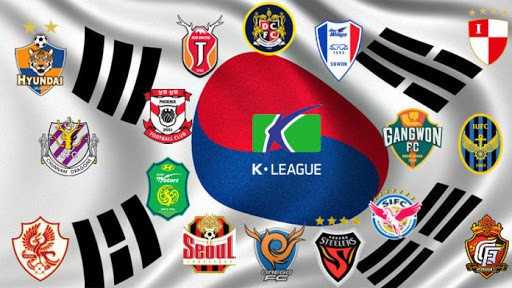
Ultimate Betting and Trading Guide To The South Korean K League
K League: Betting and Trading Analysis
The K League in South Korea is what we call a summer league, meaning that it runs during the calendar year. It usually starts in late February / early March and runs until around early October.
The 2020 edition was due to commence on the 29th February before the league was paused due to the Coronavirus Pandemic. The good news is that it is now one of the first leagues around the world to plan to start up again.
The confirmed start date for the K League is this Friday, 8th May and, today, Football Advisor, takes an in-depth look at the K League so you can be best informed on how to tackle it from a betting and trading perspective.
K League Format
There are two divisions, the K League and K League 2, and it is the premier division, the K League, which was launched in 1983, that we will be focusing our attention on.
The league has risen from it’s original format of five teams to the current 12 team roster, with a normal 38 game season.
Those familiar with the Scottish Premiership will be familiar with how the league format works.
Every team will play each other three times, and then the league splits into two groups, top six and bottom six, with the group of six playing each other one final time.
However, due to the impacts of the Coronavirus, the league has been shortened with teams only playing each other twice before the split. Effectively writing off one series of games of 11 between the sides – the revised number of games will be 27.
The K League Champions, Runners-Up and Third Place sides all qualify for the AFC Champions League.
Two sides are relegated each season to the K League, although Sangju Sangmu have already been relegated, before the season even starts. More on the reasons why for this in a moment.
K League – Top Teams
The K League has been dominated by Jeonbuk Hyundai Motors in recent years, who have won the title for three consecutive seasons. Going back further, they have won five of the last six editions and seven of the last eleven seasons. Although, Jeonbuk, managed by Jose Mourinho’s former assistant, Jose Maris, did only win the league on goal difference last season – so there are signs that this dominance may be under threat.
FC Seoul were the last time to win the league outside of Jeonbuk, back in 2016 and again in 2012. The only other Champion in the last 11 years has been Pohang Steelers in 2013.
– K League – 2019 Season
Last Season Ulsan Hyundai were leading the league by three points going into the final game but a shock 1-0 defeat to fourth placed Pohang Steelers, handed Jeonbuk their third title in a row on goal difference.
FC Seoul finished third, while the aforementioned Pohang Steelers finished fourth. Daegu and Gangwon rounded out the top six.
In 2018 the top six looked pretty similar, with Suwon and Jeju United replacing FC Seoul Daegu.
Going back a further season and FC Seoul were back in the top six, replacing Pohang Steelers.
A Special Mention for… Sangju Sangmu
Sangju Sangmu finished sixth back in 2016, the last time, they made the final group of six. Sangmu are a very unique side as they comprise entirely of footballers serving their compulsory two year national service in the South Korean Military.
The players play for the duration of their National Service, before being sent back to their previous club after the two years.
This year, being a Sangmu fan, is even more tough than normal. Sangju Sangmu are moving their franchise from their home in Sangju at the end of the season and according to K League rules, the team has already been relegated and will need to start next season in K League 2.
How To Profit From the K League
It’s time to turn out attention to the nuts and bolts of the K League, and most importantly how we can profit from the key K League Betting Trends and Statistics.
– K League – Home Win Percentage
Globally the average home win percentage is around 45% and the K League is actually a little below that.
40.4% of home teams won during the 2019 season. However, prior to that the the previous four seasons had all been lower than 40%
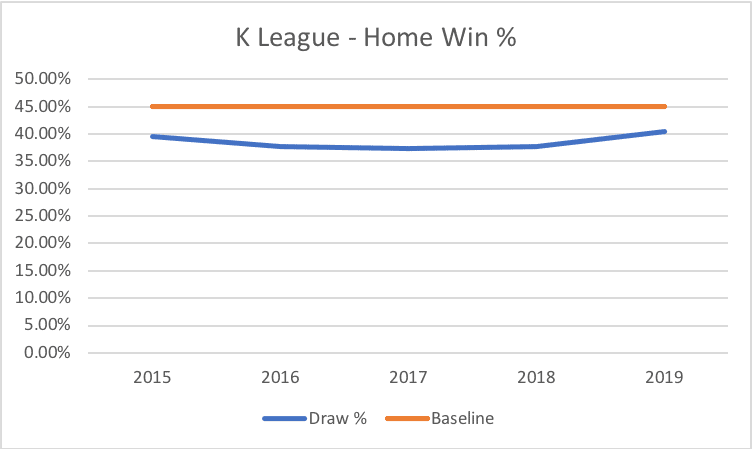
- 2019 – 40.4%
- 2018 – 37.9%
- 2017 – 37.4%
- 2016 – 37.7%
- 2015 – 39.5%
The highest home win percentage was recorded in 2011 at 44.6%
The Champions Jeonbuk won 60% of their home games, with the runners up, Ulsan, winning an impressive 68.4% of their home games. By comparison, Gangwon, who finished sixth, won 47%.

Jeju United, who came last 22% of their home games, well they did win only five games all season! Although that was not even the lost with Incheon United winning just two games.
Surprisingly as well is Daegu, who finished fifth, yet won only six home games. One more than bottom placed Jeju United.
– K League – Draw Frequency Percentage
Draws in the K League are a little above average (around 1 in 4 globally), with the draw rate sitting at around 27% – 31.6% on average. Last season it was 29.3%
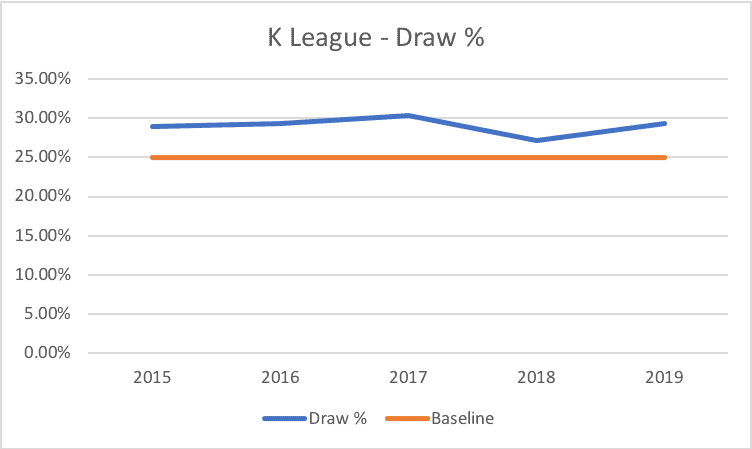
Percentage of games which result in a Draw in the K League
- 2019 – 29.3%
- 2018 – 27.2%
- 2017 – 30.4%
- 2016 – 29.4%
- 2015 – 28.9%
Gyeongnam were the draw kings last season with nine, but it was not enough to save them from relegation. Incheon United and Deagu were next up with eight a piece.
– K League – Half Time 0-0
On average we’d expect a little under a third (31%) of games to be 0-0 at half time, but the South Korean K League bucks this trend considerably.
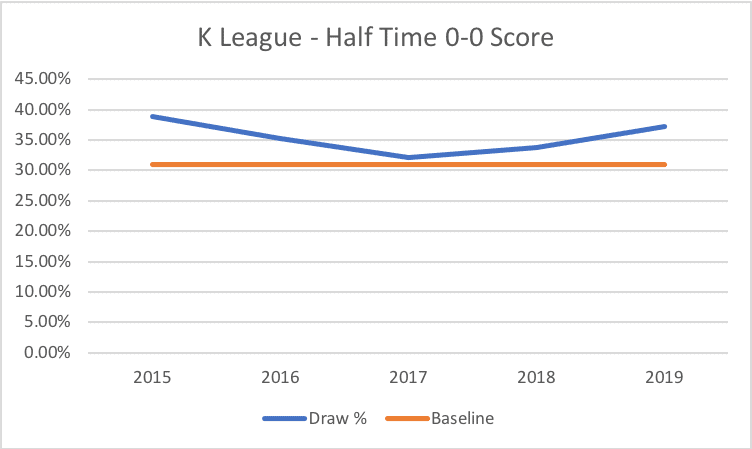
Percentage of games reaching half time with a 0-0 score line in the K League
- 2019 – 38.9%
- 2018 – 35.3%
- 2017 – 32.2%
- 2016 – 33.8%
- 2015 – 37.3%
– K League – Full Time 0-0
Again, we’d expect nil nil rates to be around 5-7% but as with the half time scoreline, the the average 0-0 ratio in the K League is above average.

Percentage of games that finished with a 0-0 score line in the K League
- 2019 – 8.6%
- 2018 – 10.3%
- 2017 – 8.8%
- 2016 – 9.6%
- 2015 – 12.7%
We’ll look at the average goal markets in a moment but these signs all indicate that it’s not a league that traditionally has a lot of goals. However, rather than avoiding it from a trading perspective, it presents a number of value trading opportunities with careful game selection – just make sure the game is in-play first!
– K League – Goal Betting
There has been a up tick in goals scored in recent season, which is clearly demonstrated by the 1.5 goal market, which has hit a 72% of higher ratio in each of the last four seasons. 2019, setting a new high with 77.3% of all games hitting over 1.5 in 2019.
It would seem, therefore, that although there is perhaps a higher chance of catching a 0-0 than normal, yet, if a game get a goal, then the matches generally open up more, with further goals are likely.
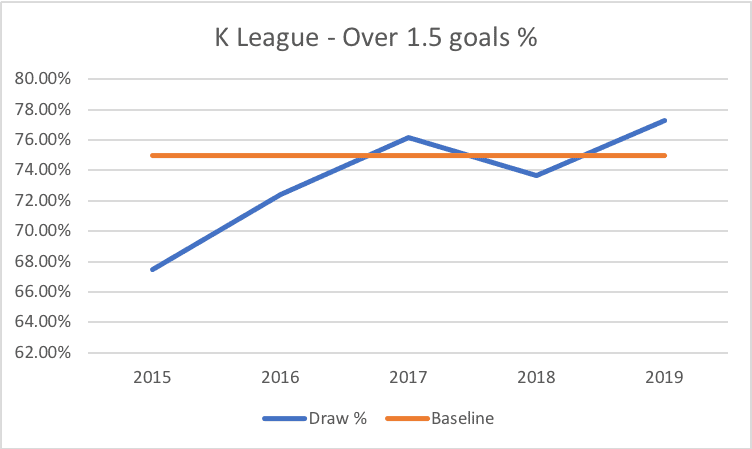
Percentage of games that finished with over 1.5 goals in K League
- 2015 – 67.5%
- 2016 – 72.4%
- 2017 – 76.2%
- 2018 – 73.7%
- 2019 – 77.3%
Interestingly, despite the increase in Over 1.5 goals in 2019, over 2.5 goals actually dropped below 50% for the first time in four seasons. Over 3.5 goals also saw a similar drop to Over 2.5, so it may be worth watching the early rounds to see if we are going to return to the positive trends, or if last seasons drop will continue.
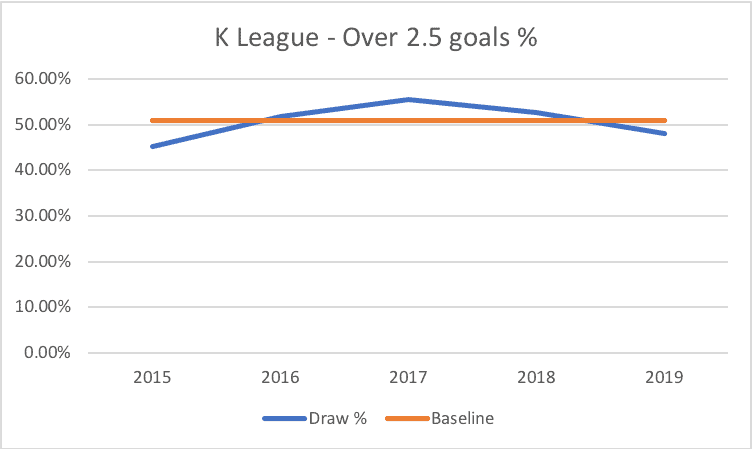
Percentage of games that finished with over 2.5 goals in K League
- 2015 – 45.2%
- 2016 – 51.8%
- 2017 – 55.5%
- 2018 – 52.7%
- 2019 – 48.0%
Percentage of games that finished with over 3.5 goals in K League
- 2015 – 20.2%
- 2016 – 30.3%
- 2017 – 30.0%
- 2018 – 29.5%
- 2019 – 23.2%
– K League – Both Teams To Score
Perhaps the most positive and consistent trend in recent times for the K League is the Both Teams To Score Market.
Globally we’d expect the average percentage to be around 50-51% but in South Korea, it has consistently been above this rate.
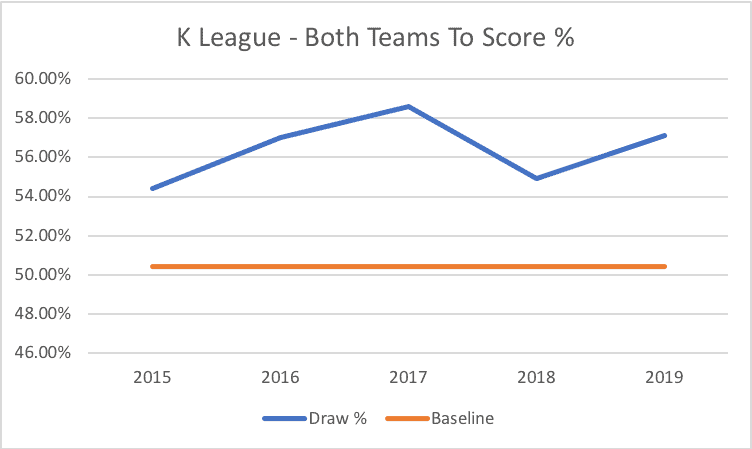
Percentage of games with both teams scoring in the K League
- 2015 – 54.4%
- 2016 – 57.0%
- 2017 – 58.6%
- 2018 – 54.9%
- 2019 – 57.1%
The clear message would appear to be that the best way to tackle the K League is waiting for the first goal to be scored, lay the scoring team with the objective of a Lay to Back trade. Without any analysis, based on previous seasons, you’d have an average 55% success rate as your base line.
For the more conservative, you could consider splitting your trading stake across the Over 2.5 goal market and laying the leading side to provide cover if the winning side scores the second goal. If you do get the losing side scoring the equaliser then you will likely be able to profit in both markets.
– K League – Season Goal Spreads
Taking a look at the last 10 seasons and we can see a pretty clear spread of which months are the most ‘fruitful’ for goals.
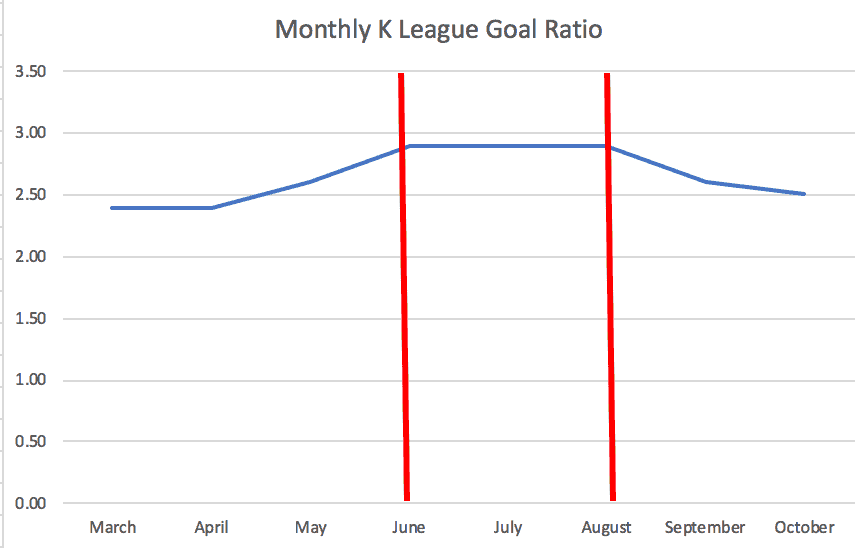
Average Monthly Goal Volume for the last 11 Seasons in the K League
- Mar – 2.4
- Apr – 2.4
- May – 2.6
- June – 2.9
- July – 2.9
- Aug – 2.9
- Sep – 2.6
- Oct – 2.5
We can see that, under normal conditions, the middle part of the season is where we will see the strongest flow of goals. However, with the season being shortened and only two main rounds, rather than three, this goal pattern is likely to be condensed into a shorter period.
One possible theory is that with the K League being the only active league, aside from Belarus, it could result in less goals early on, with the whole world watching, as has seemed to be the case in Belarus recently. Conversely, K League players may see this as an opportunity to impress and showcase for moves to Europe – meaning there will be a higher tempo and players more motivated.
Where To Watch South Korean K League
The opening match on Friday night will kick off at 7pm, local time, which is 11am British Summer Time.
The match will take place between last seasons Champions, Jeonbuk Hyundai Motors and Samsung Bluewings. The K League have confirmed that the match will be broadcast live on both their YouTube and Twitter channels. It will also include English graphics and commentary from Australia's Simon Hill.
There will also be live matches this season carried by sports broadcasters skySports, IB Sports, and Life and Sports TV.
JTBC, skySports and IB Sports will together show live coverage of 90 per cent of top-tier K League 1 matches this season. Sports TV and IB Sports will show live matches from the second-tier K League 2. It is also very likely that most matches will be available on Betfair.
K League Betting Summary
- We'll be supporting poor old Sangju Sangmu
- We'll be focusing on trading over betting in the early weeks
- We'll be waiting for a goal before getting involved
- We'll be watching the early goal trends and match plays closely to see how they align with our trends
- And we'll be cracking a beer at 11am on Friday – that's not to early is it?
Lastly, if you enjoyed this guide and would like us to continue this for each league as they come back online, let us know in the comments below.

Jon is the Founder and Chief Tipster at Football Advisor and Predictoloy. He started life as data analyst in the digital marketing field before find his true calling in the world of Football and Horse Racing Betting.
Jon has been sharing his professional expertise since 2009 and specialises in using objective data analysis and subjective experience of betting built up over more than a decade of professional betting.
In 2014, Jon also launched (and continues to run) the trusted Football Advisor service service which provides a variety of football and horse racing betting models and portfolios. A few years later, Jon launched the Predictology platform which is the worlds first betting system builder and analyser covering a wealth of football betting related statistics covering more than 200,000 matches.
Jon has also lent his knowledge and expertise to several of the trusted Premium Services offered by the respected Secret Betting Club, including Football Lay Profits. Racing Bet Profits and, most recently, Racing Lay Profits.
